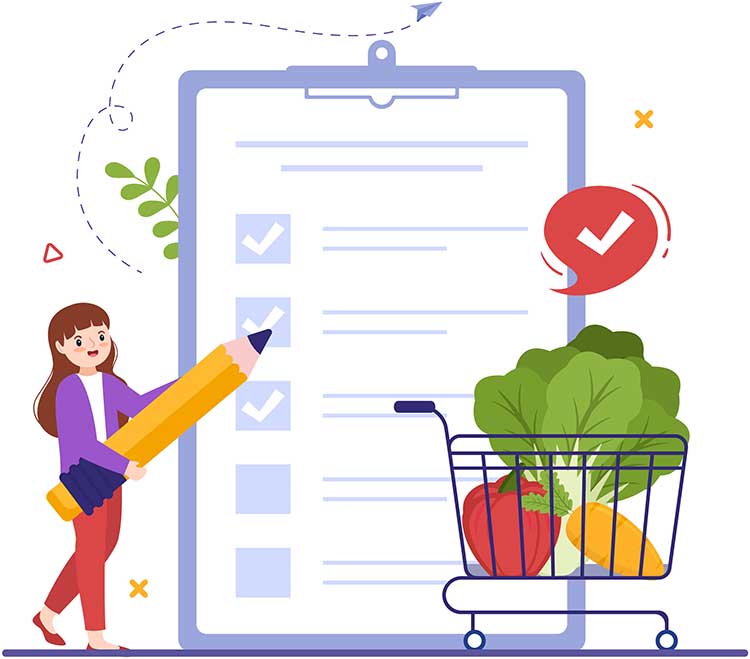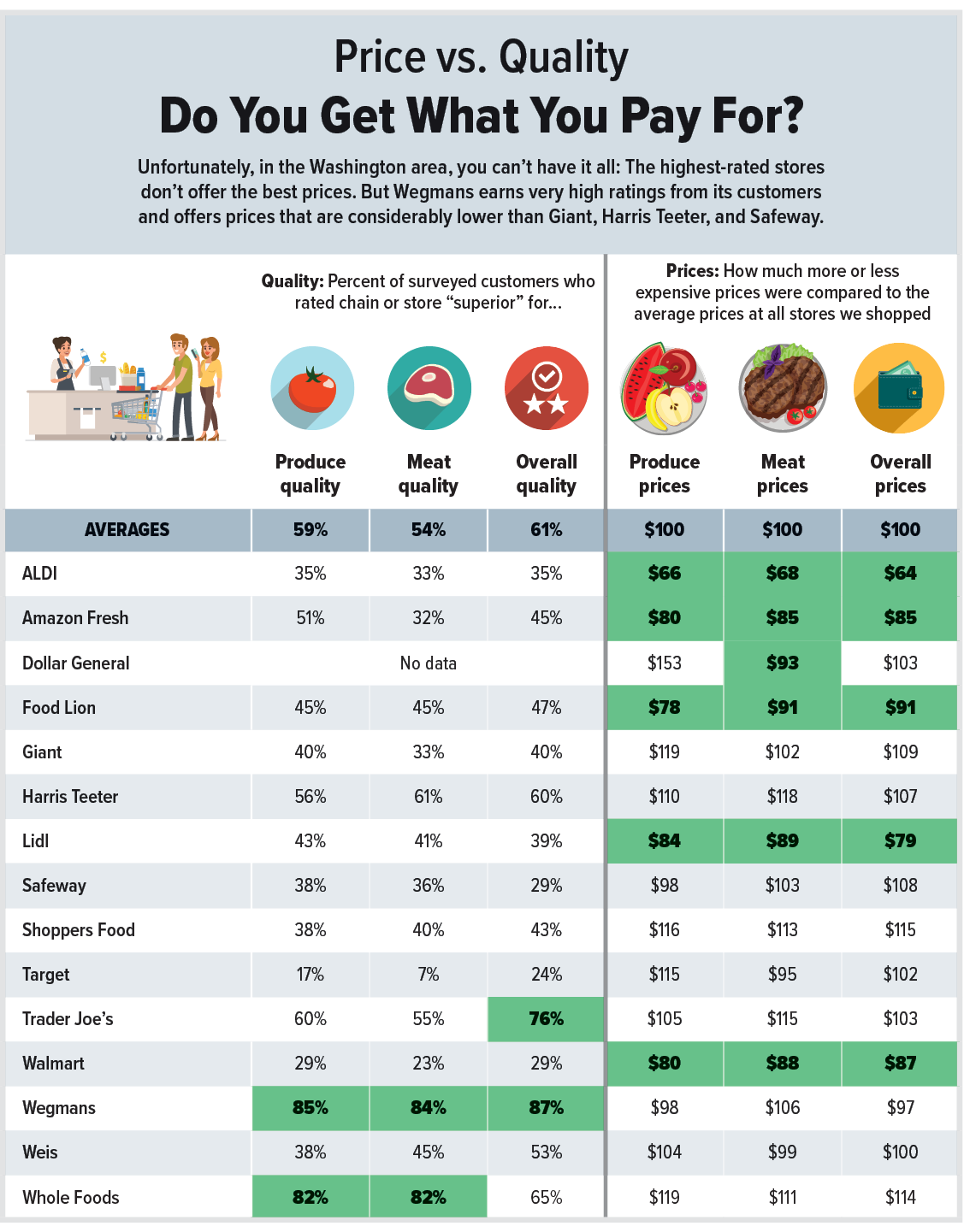Which Grocery Stores Offer the Best Prices and Quality?
Last updated November 2025

Our latest comparison of Washington area supermarkets’ prices and quality is in the bag. Consumers’ Checkbook researchers shopped stores using a 150-item list to compare prices. To evaluate stores on quality of products and service, we surveyed our members. The figures below summarize our findings; for details, see our Ratings Tables. Here’s what we found:
Wegmans wins again.
Wegmans continues its slow-but-steady East Coast expansion and now has more than a dozen stores in the DMV. Since opening its first D.C.-area location in 2004, the Rochester-based chain has consistently earned high ratings from its customers for quality. In our latest survey, 87 percent of its customers judged it “superior” overall, and 85 percent rated its produce “superior.”
Although Wegmans’ prices aren’t among the lowest in the region, it remains competitive. On average, its prices were about 10 percent lower than average prices at Giant, Harris Teeter, and Safeway, and 15 percent lower than Whole Foods.
ALDI and Lidl offer the biggest savings.
German-based discounters ALDI and Lidl, ubiquitous in most of western Europe, continue to expand their U.S. footprints. These chains focus on low costs, and our survey found them quite inexpensive: For our shopping list, ALDI’s prices were 36 percent lower than the all-store average, and Lidl’s were 21 percent lower. ALDI’s per-unit prices were even lower than BJ’s, Costco, and Sam’s Club.
These savings are partly explained by ALDI’s and Lidl’s smaller-format stores, which have much lower overhead costs than conventional supermarkets.
ALDI and Lidl also benefit from different expectations. Shoppers at Giant, Safeway, Walmart, etc., expect to always find their favorite brands in a variety of sizes on the shelves. Like Trader Joe’s, ALDI and Lidl carry mostly their own brands, not national-brand products. ALDI and Lidl do offer some national brands, but overall, selection is limited. In other words, you’ll find some of the most popular brands (Coke, Heinz ketchup, Hellmann’s mayo, etc.) at ALDI and Lidl, but probably only in one size.
So, shoppers at quirky ALDI and Lidl don’t expect wide choices of brands or sizes. Instead, they’re being offered comparable products in exchange for big savings. (To account for brand differences, we used a modified market basket to compare prices at ALDI, Lidl, and Trader Joe’s to prices at conventional supermarkets; click here for more info.)
Other low-price standouts: Amazon Fresh, Walmart, and Food Lion.
Amazon Fresh’s prices were about 15 percent lower than the all-store average, Walmart’s 13 percent lower, and Food Lion’s nine percent lower.
For a family that spends $300 per week at the supermarket, a 15 percent price difference totals savings of $2,340 per year; a nine percent price difference totals $1,404 a year.
Amazon Fresh opened its first Washington area location in 2021; the region now has eight and counting. These small-format stores focus on low costs and convenience (the company’s app keeps track of what you remove from shelves; when finished, you simply exit without scanning items).

Giant, Harris Teeter, and Safeway charged similar prices.
Overall, the area’s biggest conventional supermarket chains had prices that were higher than average—and within one or two percent of one another. Giant, Harris Teeter, and Safeway were about 25 percent more expensive than Walmart and 27 percent more than Amazon Fresh.
Whole Foods remains an expensive choice—and its ratings for quality continue to dip.
When Amazon purchased Whole Foods in 2017, many experts predicted the combination would punish its supermarket competition by combining Whole Foods’ solid reputation with Amazon’s pursuit of distribution perfection. Many consumers hoped they’d pay Amazon-like prices for Whole Foods-quality products. That hasn’t materialized.
Whole Foods built a loyal following by offering high-quality produce, meat, prepared foods, and generic staples. For years it earned high marks in our surveys of consumers, especially for produce and meat quality. Now, Whole Foods’ customers give it far lower scores: On our “overall quality” survey question its score has dropped from more than 90 percent to 65 percent.
Our price survey found that Whole Foods remains the most expensive choice among the large chains we shopped. Its overall prices were about 14 percent higher than the average prices at all stores we surveyed, or about 18 percent higher than top-rated Wegmans and 34 percent higher than Amazon Fresh, its corporate sibling.
Target has inconsistent pricing from location to location.
Prices at the Target we shopped in the District were about six percent higher than the all-store average, but those at the Alexandria store we surveyed were about three percent lower than average. This difference mirrors results from our previous surveys.
For other large chains prices weren’t affected much by store location.
Shoppers Food now offers higher prices than even Whole Foods.
The local chain, which 25 years ago provided one of the few low-priced options to former juggernauts Giant and Safeway, now operates only seven area stores and its prices were 15 percent higher than the average for all supermarkets we surveyed.
Most large chains received low marks from their customers. Safeway, Target, and Walmart were rated lowest.
Target was rated “superior” overall by only 24 percent of its surveyed customers, and Safeway and Walmart each by only 29 percent.
ALDI, Amazon Fresh, Food Lion, Giant, Lidl, and Shoppers Food all received “superior” ratings for “overall quality” by fewer than half of their surveyed customers.

Harris Teeter continues to earn higher ratings than its main rivals.
While Harris Teeter’s prices were about the same as those at Giant and Safeway, it continues to receive far higher marks than the other largest conventional supermarket chains on our customer survey questions on quality. Harris Teeter received “superior” ratings for “overall quality” from 60 percent of its surveyed customers. It also received considerably higher scores than Giant and Safeway for “quality of fresh produce,” “quality of meats,” “staff helpfulness/pleasantness,” and all other survey questions.
Trader Joe’s remains popular.
Seventy-six percent of survey respondents rated the funky-and-fun chain “superior” for “overall quality.” Although not a price leader in the area, TJ’s prices were about five percent lower than the Giant/Harris Teeter/Safeway average and about six percent higher than Wegmans.
MOM’s Organic Market and a handful of other specialty stores receive raves.
Along with Wegmans, for produce, Grosvenor Market, MOM’s, Sprouts Farmers Market, and The Fresh Market received the highest scores for quality. For fresh meat quality, Balducci’s, Grosvenor, and The Fresh Market were all rated “superior” by more than 90 percent of their surveyed customers.
We also checked out warehouse clubs; looked at unique stores Trader Joe’s, ALDI, and Lidl; and examined grocery delivery options.
Check out the other articles in our “Grocery Stores” category and our ratings tables for info on all the local grocery options, how we rated them, and tips on saving no matter where you shop.

